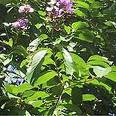It’s strawberry and cream time again, although in Pakistan strawberries (also called the same in Urdu) they are a burgundy colour rather than the red of European strawberries. To me they are irresistible, although some people are allergic to them and so are others if they eat too many of them at a sitting. They can bring out a red rash on sensitive skins, so eat them in moderation.
Wild strawberries, Fragaria vesca, grow in many parts of the world, and these have a very different taste from the common or garden strawberry that is ubiquitous today. Fragaria in Latin means fragrant, which aptly describes this fruit. This should not be surprising as they are members of the rose family of plants. Strawberries are delicious for tortoises and green snakes, as I know from first-hand experience. The tortoise I had as a child once frightened me because its mouth was red and I thought it was bleeding, but on closer inspection it had been gorging on strawberries in the garden and was covered in their sweet red juice. In Greece little green snakes, which are not particularly venomous, tend to gather in strawberry fields, so be careful.
 The strawberry we know today was developed early in the 18th century after a Frenchman took seeds from Fragaria chileonensis, the South American variety, back to Europe and successfully crossed these with the Virginian strawberry which was imported from North America into Europe. This hybrid is the strawberry we have today, although there are now many cultivars.
The strawberry we know today was developed early in the 18th century after a Frenchman took seeds from Fragaria chileonensis, the South American variety, back to Europe and successfully crossed these with the Virginian strawberry which was imported from North America into Europe. This hybrid is the strawberry we have today, although there are now many cultivars. The strawberry is the only fruit so far discovered which has seeds on its exterior, and they can contain as many as 200 seeds. They are rich in vitamins and minerals as well as containing amino acids. Beta-carotene is also present in strawberries so they are a valuable, as well as delicious, fruit to include in our diets. They have a high sugar content, though so are not so good if you are trying to lose weight. Among other things they contain vitamins A, C, E, K and the B-complex vitamins, and are a good source of calcium, iron, potassium, phosphorous, manganese, copper and zinc with a little selenium too. The vitamins and minerals present in strawberries have potent antioxidant properties so they are very good for our health. They are also rich in bioflavonoids and some of these can reduce the rate of reproduction of cancerous cells, although not all phytonutrients and bioflavonoids in the strawberry have been identified, it is believed.
 They are good for us as cosmetic preparations too, as if you cut a strawberry and apply it to your face, it will remove a slight sunburn and whiten the complexion. If it is a bad sunburn you should apply strawberry juice to the affected area and leave it on for half an hour before rinsing it off with warm water. Try to avoid using soap to wash it off though as this may cause irritation.
They are good for us as cosmetic preparations too, as if you cut a strawberry and apply it to your face, it will remove a slight sunburn and whiten the complexion. If it is a bad sunburn you should apply strawberry juice to the affected area and leave it on for half an hour before rinsing it off with warm water. Try to avoid using soap to wash it off though as this may cause irritation. Strawberry roots have been traditionally used in medicine to make a tisane, as have the leaves which is said to stop diarrhoea and dysentery. Take a handful of fresh leaves to a cup of boiling water and allow them to steep for 10 – 15 mins before straining and drinking a few cups a day.
Strawberries are wonderful on their own, but you could try this salad with a difference.
STRAWBERRY AND CUCUMBER SALAD
Ingredients
½ kilo fresh strawberries
1 cucumber, peeled and cut into slices
freshly ground black pepper
Method
Halve the strawberries and mix with the cucumber slices.
Grind black peppercorns over them to taste.
This might sound a little strange, but the pepper really brings out the flavour of the strawberries. You can use the cucumber peel as a skin toner and place a slice of it over each eye to get rid of puffiness.
This has Taste and is a Treat.














